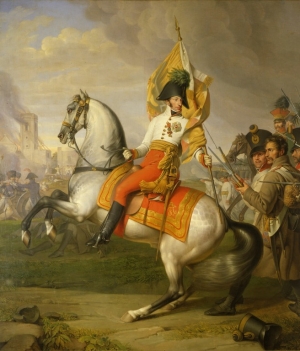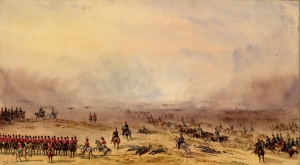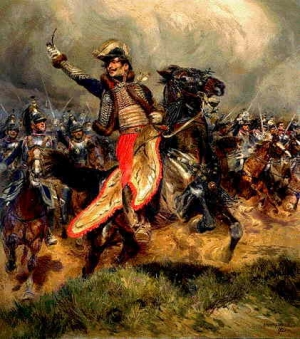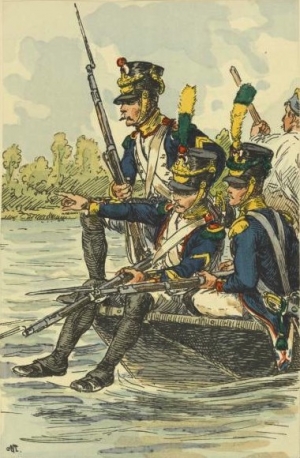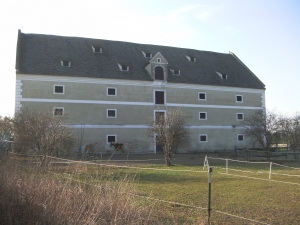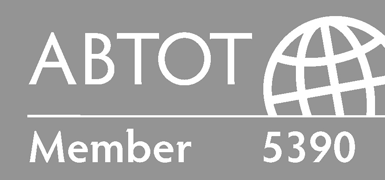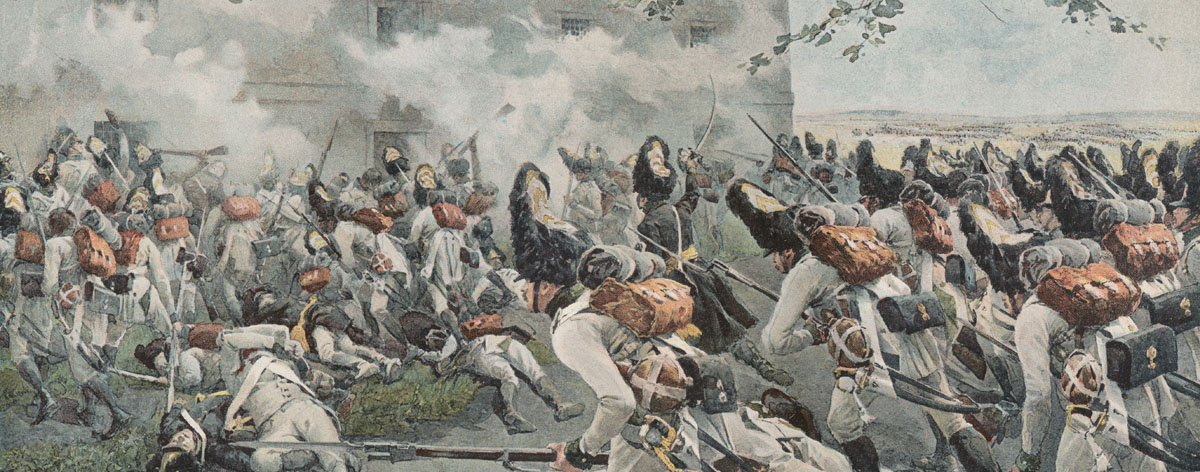
To be confirmed
Tour Introduction
During this comprehensive nine-day tour of Napoleon’s 1809 campaign we explore the major battles and actions fought in Bavaria and Austria. From our base in Landshut we examine the missed opportunities of the Austrians and see how the French reaction, initially confused, developed into one that once again nearly enveloped their enemy’s army. Traveling down the Danube valley in the footsteps of French Army, we’ll enjoy some dramatic views of that powerful river barrier and appreciate how its tributaries and surrounding hills impacted the pursuit as we look at selected rearguard battles fought by the Austrians. Transferring our base to the Habsburg capital of Vienna allows us to cross into Hungary to consider the important supporting role played by the emperor’s stepson, Prince Eugene, and fully explore the events on the Marchfeld that took place from late May to early July 1809 culminating in the massive battle of Wagram and the armistice that brought an end to the war at Znaim (Znojmo). We will visit some of the greatest military collections in the world at Ingolstadt, Vienna and Forchtenstein and spend an afternoon in Napoleon’s favourite residence outside of France: Schönbrunn Palace.
Background
Early on the morning of 10 April 1809, shivering Bavarian cavalry pickets peered across the murky River Inn to see Austrian horsemen looming out of the fog on the far bank. These Austrians were the outriders of a huge host, 120,000 warriors of the Habsburg Empire whose twisting columns stretched along muddy roads twenty-five kilometres to the east. The Bavarian troopers did not wait to be accosted but spurred their mounts and sped west with news of the invasion. The War of 1809 had begun.
The 1809 war had its origins in the revanchist attitudes of a ‘war party’ in the Habsburg hierarchy. Led by Count Stadion, they were alarmed by French intervention in Spain and perceived their dynasty’s fate in Napoleon’s dethronement of the Spanish ruling house. As Spanish regulars and guerrillas stymied French forces, however, this group came to believe there was an opportunity to launch an offensive in central Europe while the French emperor was distracted in Iberia. Hoping to redress the territorial losses and humiliations that had been heaped upon their empire by France since 1797, the war party impatiently and incessantly harangued their emperor, Kaiser Franz I, and, in February 1809, they succeeded in persuading him to agree to an offensive war against France. But the Austrian army was not ready. Austria’s senior commander, the able Archduke Charles, had begun a series of major reforms after the disastrous defeats of 1805, but these were incomplete, and he argued against a premature war. His concerns overridden in the urgent enthusiasm of the moment, the old empire launched itself into war with near-simultaneous invasions of Bavaria, Italy and Poland. When the Austrian declaration of war was delivered to local French commanders, the French Army was scattered across Germany under no overall command. Hoping to avoid provocation, Napoleon had kept himself in Paris, appointing his trusted Chief of Staff, Marshal Berthier, to manage his army’s concentration and command the initial French reaction to the invasion of Bavaria. In these early days of the campaign the Austrians would have no better an opportunity to defeat the French in detail until Napoleon’s appearance on the scene. To the end of his life Napoleon would be proud of the five days’ fighting that ensued. He would be less pleased with the later results of the stalemate at Aspern-Essling and the cost of the bloody victory at Wagram, but in the end, he required only three months to defeat the Habsburg Empire once again.
Highlights
- The opening battles in Bavaria
- Travel along the picturesque Danube Valley
- The fabulous military museums in Ingolstadt and Vienna
- The battle of Raab in Hungary
- The fantastic weapons and uniforms collections at Forchtenstein Castle
- The battle of Aspern-Essling and Lobau island
- The magnificent Schönbrunn Palace
- The battle of Wagram and associated anniversary events
- The final battle and armistice in Znaim, Czechia
What's Included
- 4 Star Hotels
- Return flights from London (optional)
- Expert historians throughout providing a daily variety of talks, presentations and Q&A
- Dedicated Tour Manager
- Dinner parties hosted by your expert historians and tour manager
- The company of like-minded travelers
- Helpful and friendly travel advice
- Meals as indicated in the itinerary
- Two drinks i,e wine or beer at each dinner and a welcome drink on first evening
- Entrance fees for sites included in itinerary
- Tour information booklet
- Modern, comfortable, air-conditioned coach
"We are going to Vienna where we shall know how to punish Austria for the harm she has done"
Napoleon to the Bavarian Army 20 April 1809
Itinerary
Day 1: Introduction. Fly from London and/or join tour group at Munich airport. Transfer to our hotel in Landshut for three nights. Enjoy pre-dinner drinks and introductory talk (D).
Day 2: Opening moves. This morning we visit the superb Bavarian Army Museum in Ingolstadt. In the afternoon we stand on the ridge where Davout halted the Austrian exploitation at Hausen/Teugen (Thann) on 19 April and then explore the clashes that constituted the battle of Abensburg the following day (B,L,D)
Day 3: French counterstrokes. We discuss Napoleon’s drive on Landshut and the resultant action there and then, as he did, drive north to the rolling fields surrounding Eckmühl, little changed over the years and the scene of the battle of 22 April. After a lunch break in Regensburg (Ratisbon) we visit the pantheon-like Walhalla monument conceived in 1807 to honour the heroes of ‘Greater Germany’. (B,D)
Day 4: On to Vienna! Drive to the Pöstlingberg, high above the Danube valley from where we gain stupendous views over Linz and discuss the battle that saw the Germans under Vandamme and Bernadotte defend the north bank bridgehead against the assaulting Austrians under Kolowrat on 17 May. This afternoon we discuss the bloody storming of Ebelsberg of 3 May: at the site of the trestle bridge over the River Traun we appreciate the challenge facing Massena’s men assaulting the strong Austrian positions around the schloss, cemetery and upon the Schiltenberg. Continue to Vienna and check-in to our hotel for five nights. (B,D)
Day 5: Aspern-Essling and Schönbrunn. Although much of the field of the inconclusive battle of Aspern-Essling has been built over, visit the Essling granary and Aspern museum and to the north examine the ground over which Lannes developed his attack. This afternoon we visit Schönbrunn Palace to enjoy a guided tour around the imperial apartments including those occupied by Napoleon in 1805 and 1809 and where his son, the Duke of Reichstadt, died in 1832. (B)
Day 6: Forchtenstein and Raab. We indulge in a guided tour of one of Europe’s largest private armouries with its magnificent collection of weapons, uniforms and paintings which reflect the long tradition of the Esterhazy family’s loyal service to the Habsburgs. This afternoon we cross into Hungary to explore the battlefield of Raab where, on 14 June, Prince Eugene defeated Archdukes John and Joseph so preventing them from uniting with Charles’ forces prior to Wagram. (B,D)
Day 7: Wagram. We spend the morning on foot exploring the island of Lobau discussing the French logistical and engineering challenges that had to be overcome prior to the battle of Wagram. Crossing to the north bank we follow the French exploitation from Gross-Enzersdorf over the Marchfeld up to the ‘heights’ on the far side of the Russbach stream staunchly defended from Markgrafneusiedl to Wagram. At the latter we visit the wonderful little museum and then stand on the spot from where Napoleon commanded the second day’s battle. (B,D)
Day 8: Pursuit. Taking the route followed by Massena we examine the Austrian rearguard actions at Hollabrunn and Schöngrabern which delayed the arrival of that marshal before Znaim. At Znaim itself, we debate the actions of the impetuous and isolated Marmont to fix the retreating Austrians, examine Massena’s assault on the town and visit the ‘Red Yard’ where Napoleon agreed to the armistice which brought an end to the war. (B,D)
Day 9: Home. We spend the morning exploring one of Europe’s foremost military museums, the Heeresgeschictlishes Museum, in particular its Napoleonic and Revolutionary Wars Hall. Transfer to Vienna airport to leave the tour or take the return flight to London. (B)

